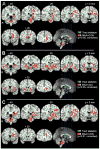White matter microstructural alterations in children with prenatal methamphetamine/polydrug exposure
- PMID: 23149028
- PMCID: PMC3634917
- DOI: 10.1016/j.pscychresns.2012.04.017
White matter microstructural alterations in children with prenatal methamphetamine/polydrug exposure
Abstract
Little is known about the effects of prenatal methamphetamine exposure on white matter microstructure, and the impact of concomitant alcohol exposure. Diffusion tensor imaging and neurocognitive testing were performed on 21 children with prenatal methamphetamine exposure (age 9.8±1.8 years; 17 also exposed to alcohol), 19 children with prenatal alcohol but not methamphetamine exposure (age 10.8±2.3 years) and 27 typically developing children (age 10.3±3.3 years). Whole-brain maps of fractional anisotropy (FA) were evaluated using tract-based spatial statistics. Relative to unexposed controls, children with prenatal methamphetamine exposure demonstrated higher FA mainly in left-sided regions, including the left anterior corona radiata (LCR) and corticospinal tract Post-hoc analyses of these FA differences showed they likely result more from lower radial diffusivity (RD) than higher axial diffusivity (AD). Relative to the methamphetamine-exposed group, children with prenatal alcohol exposure showed lower FA in frontotemporal regions-particularly, the right external capsule. We failed to find any group-performance interaction (on tests of executive functioning and visuomotor integration) in predicting FA; however, FA in the right external capsule was significantly associated with performance on a test of visuomotor integration across groups. This report demonstrates unique diffusion abnormalities in children with prenatal methamphetamine/polydrug exposure that are distinct from those associated with alcohol exposure alone, and illustrates that these abnormalities in brain microstructure are persistent into childhood and adolescence--long after the polydrug exposure in utero.
Copyright © 2012 Elsevier Ireland Ltd. All rights reserved.
Figures




Similar articles
-
White matter integrity and cognitive performance in children with prenatal methamphetamine exposure.Behav Brain Res. 2015 Feb 15;279:62-7. doi: 10.1016/j.bbr.2014.11.005. Epub 2014 Nov 12. Behav Brain Res. 2015. PMID: 25446763 Free PMC article.
-
Lower diffusion in white matter of children with prenatal methamphetamine exposure.Neurology. 2009 Jun 16;72(24):2068-75. doi: 10.1212/01.wnl.0000346516.49126.20. Epub 2009 Apr 15. Neurology. 2009. PMID: 19369643 Free PMC article.
-
Sex-Specific Alterations of White Matter Developmental Trajectories in Infants With Prenatal Exposure to Methamphetamine and Tobacco.JAMA Psychiatry. 2016 Dec 1;73(12):1217-1227. doi: 10.1001/jamapsychiatry.2016.2794. JAMA Psychiatry. 2016. PMID: 27829078 Free PMC article.
-
Effects of Prenatal Methamphetamine Exposure on the Developing Human Brain: A Systematic Review of Neuroimaging Studies.ACS Chem Neurosci. 2021 Aug 4;12(15):2729-2748. doi: 10.1021/acschemneuro.1c00213. Epub 2021 Jul 23. ACS Chem Neurosci. 2021. PMID: 34297546 Free PMC article.
-
Structural, metabolic, and functional brain abnormalities as a result of prenatal exposure to drugs of abuse: evidence from neuroimaging.Neuropsychol Rev. 2010 Dec;20(4):376-97. doi: 10.1007/s11065-010-9150-x. Epub 2010 Oct 28. Neuropsychol Rev. 2010. PMID: 20978945 Free PMC article. Review.
Cited by
-
Fetal Alcohol Spectrum Disorders: Recent Neuroimaging Findings.Curr Dev Disord Rep. 2014 Sep;1(3):161-172. doi: 10.1007/s40474-014-0020-8. Curr Dev Disord Rep. 2014. PMID: 25346882 Free PMC article.
-
Structural imaging for addiction medicine: From neurostructure to neuroplasticity.Prog Brain Res. 2016;224:105-27. doi: 10.1016/bs.pbr.2015.07.029. Epub 2015 Oct 27. Prog Brain Res. 2016. PMID: 26822356 Free PMC article. Review.
-
Does Prenatal Exposure to CNS Stimulants Increase the Risk of Cardiovascular Disease in Adult Offspring?Front Cardiovasc Med. 2021 Mar 4;8:652634. doi: 10.3389/fcvm.2021.652634. eCollection 2021. Front Cardiovasc Med. 2021. PMID: 33748200 Free PMC article. Review.
-
Altering Cell-Cell Interaction in Prenatal Alcohol Exposure Models: Insight on Cell-Adhesion Molecules During Brain Development.Front Mol Neurosci. 2021 Dec 15;14:753537. doi: 10.3389/fnmol.2021.753537. eCollection 2021. Front Mol Neurosci. 2021. PMID: 34975396 Free PMC article. Review.
-
Neuroimaging in infants with prenatal opioid exposure: Current evidence, recent developments and targets for future research.J Neuroradiol. 2021 Mar;48(2):112-120. doi: 10.1016/j.neurad.2020.09.009. Epub 2020 Oct 13. J Neuroradiol. 2021. PMID: 33065196 Free PMC article. Review.
References
-
- Anon . Results from the 2007 NSDUH: National Findings, Substance Abuse and Mental Health Services Administration. Rockville, MD: 2008.
-
- Astley SJ. Diagnostic guide for fetal alcohol spectrum disorders: the 4-digit diagnostic code. University of Washington; Seattle, WA: 2004.
-
- Bashat DB, Kronfeld-Duenias V, Zachor DA, Ekstein PM, Hendler T, Tarrasch R, Even A, Levy Y, Sira LB. Accelerated maturation of white matter in young children with autism: a high b value DWI study. Neuroimage. 2007;37:40–7. - PubMed
-
- Beaulieu C. The basis of anisotropic water diffusion in the nervous system - a technical review. NMR in Biomedicine. 2002;15:435–55. - PubMed
-
- Beery K. The Beery-Buktenica Developmental Test of Visual-Motor Integration: Administration, Scoring, and Teaching Manual. 4. Modern Curriculum Press; Parsippany, NJ: 1997.
Publication types
MeSH terms
Substances
Grants and funding
LinkOut - more resources
Full Text Sources
Medical
Miscellaneous

